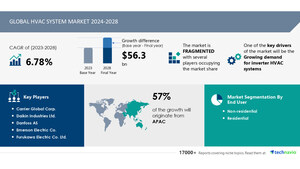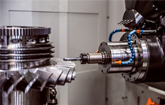NEW YORK, Oct. 1, 2024 /PRNewswire/ -- Report with market evolution powered by AI - The Global Forklift Trucks Market size is estimated to grow by USD 23.26 billion from 2024-2028, according to Technavio. The market is estimated to grow at a CAGR of almost 7.2% during the forecast period. Rapid growth in construction sector is driving market growth, with a trend towards fuel cell-powered forklift trucks. However, shortage of skilled operators poses a challenge - Key market players include Anhui Heli Co. Ltd., BYD Co. Ltd., Cargotec Corp., Caterpillar Inc., CLARK Material Handling Co., Crown Equipment Corp., CVS FERRARI Spa, Dana Inc., EP Equipment Co. Ltd., Hoist Material Handling Inc., Hyster Yale Materials Handling Inc., Jungheinrich Group, KION GROUP AG, Komatsu Ltd., Konecranes, Manitou BF SA, Mitsubishi Heavy Industries Ltd., Royal Terberg Group BV, Sany Group, and Toyota Industries Corp..
AI-Powered Market Evolution Insights. Our comprehensive market report ready with the latest trends, growth opportunities, and strategic analysis- View your snapshot now
Forecast period |
2024-2028 |
Base Year |
2023 |
Historic Data |
2018 - 2022 |
Segment Covered |
Class Type (Class III, Class V, Class I, Class II, and Class IV), Type (Electric and Internal combustion engine), and Geography (APAC, Europe, North America, Middle East and Africa, and South America) |
Region Covered |
APAC, Europe, North America, Middle East and Africa, and South America |
Key companies profiled |
Anhui Heli Co. Ltd., BYD Co. Ltd., Cargotec Corp., Caterpillar Inc., CLARK Material Handling Co., Crown Equipment Corp., CVS FERRARI Spa, Dana Inc., EP Equipment Co. Ltd., Hoist Material Handling Inc., Hyster Yale Materials Handling Inc., Jungheinrich Group, KION GROUP AG, Komatsu Ltd., Konecranes, Manitou BF SA, Mitsubishi Heavy Industries Ltd., Royal Terberg Group BV, Sany Group, and Toyota Industries Corp. |
Key Market Trends Fueling Growth
Forklift trucks are essential machinery in various industries for material handling. Manufacturers are focusing on research and development to enhance their offerings, leading to the emergence of forklifts powered by hydrogen fuel cells. This technology is gaining traction due to the need for increased operational efficiency and stricter regulations on carbon emissions. Companies like Toyota and KION GROUP are introducing fuel cell-powered models. These forklifts offer numerous benefits, including reduced downtime, longer fuel cell life, faster refueling time, and consistent performance. Hydrogen, derived from natural gas, is cheaper than diesel and LPG, making fuel cell-powered forklifts a cost-effective solution. The market for these trucks is expected to grow significantly due to their improved performance, reduced maintenance needs, and environmental advantages.
The forklift truck market is experiencing significant trends in distribution techniques and warehouse technologies. Governmental and private sector investments in industrial activities are driving the demand for advanced material handling equipment. Electric motors in forklifts are gaining popularity due to emission standards and environmental concerns. Multi-shift operations require longer battery life, leading to increased focus on battery chargers and safety equipment. Flooring, eyewash stations, and safety regulations are essential considerations. Fossil fuels like IC engines, LPG gas, gasoline, and CNG are being replaced by alternative energy forklifts such as hydrogen-powered models. The Class I segment, including counterbalanced forklift trucks, continues to dominate the lift truck market. Industries like construction, e-commerce, power generation, mining, airports, rail networks, and truck associations are key players. The Industrial Truck Association and industries such as steel, manufacturing, and precision instruments are also significant contributors.
Insights on how AI is driving innovation, efficiency, and market growth- Request Sample!
- The material handling and logistics industries require proficient forklift operators due to the complex nature of their operations. In the US, OSHA mandates certification for forklift operators, yet finding skilled labor remains a challenge. Over-reliance on existing certified operators leads to higher wages and overuse, causing delays and profitability losses. The global forklift trucks market expansion is hindered by this shortage of skilled operators, which is expected to persist during the forecast period.
- The Forklift Trucks Market in the Industrial, Logistics, and Material Handling Industries faces several challenges. Machinery industry advancements bring AI and robotics, impacting forklift demand. Connected things and automation push for electric vehicles, including electric lift trucks, over IC engine trucks. Diesel and AC trucks face tailpipe emissions concerns. Class III segment (Reach Trucks) and Class V segment (Powered Pallet Jacks) in mining and natural resource industries require IC engines. Class I, II, III, IV, and V trucks serve various sectors, from commercial warehousing and e-commerce to seaports and dockyards. Rechargeable batteries and grid electricity power electric lift vehicles, while IC engine forklifts remain essential. Companies like Konecranes innovate, addressing challenges. Forklift safety is crucial, as accidents risk inventory, freight, cars, and material damage. Electric lift vehicles handle containers, crates, and warehouse space efficiently.
Insights into how AI is reshaping industries and driving growth- Download a Sample Report
This forklift trucks market report extensively covers market segmentation by
- Class Type
- 1.1 Class III
- 1.2 Class V
- 1.3 Class I
- 1.4 Class II
- 1.5 Class IV
- Type
- 2.1 Electric
- 2.2 Internal combustion engine
- Geography
- 3.1 APAC
- 3.2 Europe
- 3.3 North America
- 3.4 Middle East and Africa
- 3.5 South America
1.1 Class III- The Class III segment of the global forklift trucks market includes electric hand rider trucks and pallet jacks, which are commonly used for quick unloading of deliveries from tractors and trailers in small warehouses and production plants. These forklifts, which have a load capacity of approximately 5 tons, are hand-controlled through a steering tiller and are available as counterbalanced or straddle-type walk-behind stackers. Class III forklift trucks are suitable for short distances and are ideal for warehouses requiring intermediate logistics between unloading and storage operations. They can be powered by lithium-ion batteries or fuel cell engines, making them an eco-friendly alternative. Japan and South Korea are expected to lead the market due to their investments in hydrogen fuel cell research and technology. Vendors such as KION GROUP AG and Toyota Industries are investing in hydrogen-powered fuel cells for class III forklift trucks, driving market growth during the forecast period.
Download complimentary Sample Report to gain insights into AI's impact on market dynamics, emerging trends, and future opportunities- including forecast (2024-2028) and historic data (2018 - 2022)
The forklift trucks market encompasses a range of material handling equipment, including Class I, II, III, and IV lift trucks. Class I trucks, also known as electric motor rider trucks, are commonly used in industrial settings and logistics industries for moving pallets and heavy loads. Advanced technology, such as rechargeable batteries and grid electricity, powers these trucks, making them ideal for commercial warehousing, e-commerce, and logistics sector applications. Class II and III trucks, which include reach trucks and narrow aisle trucks, are designed for handling long loads and tight spaces, while Class IV trucks, or sit-down counterbalanced trucks, are suitable for handling heavy loads in confined areas. The lift truck market also caters to various industries, including construction, mining, airports, power generation, and automotive, among others. Containers, crates, warehouses, dockyards, freight cars, and cars are common applications for forklift trucks.
The forklift trucks market encompasses a range of material handling equipment used in various industries for lifting, moving, and transporting heavy loads. The Class I segment, which includes counterbalanced forks, is the largest in the lift truck market. Advanced technology, such as electric vehicles, artificial intelligence, robotics, and connected things, is transforming the industry. The e-commerce industry, logistics industries, and commercial warehousing are major consumers of forklift trucks. Power generation, mining activity, construction, airports, rail networks, and the steel, manufacturing, precision instruments, and machinery industries also rely on these trucks. Rechargeable batteries and grid electricity power many electric lift trucks, while IC engine forklifts use diesel, LPG gas, or IC engines. Safety equipment, flooring, and emission standards are crucial considerations in the forklift market. Multi-shift operation and battery chargers are essential components, and safety equipment, such as eyewash stations, are necessary for operator safety. Fossil fuels, such as diesel, are being replaced by electric motors to address environmental concerns. Class III, IV, and V segments cater to specific applications, including reach trucks, pallet jacks, and rough terrain forklifts. Governmental and private sector investments in warehouse technologies and distribution techniques continue to drive market growth.
1 Executive Summary
2 Market Landscape
3 Market Sizing
4 Historic Market Size
5 Five Forces Analysis
6 Market Segmentation
- Class Type
- Class III
- Class V
- Class I
- Class II
- Class IV
- Type
- Electric
- Internal Combustion Engine
- Geography
- APAC
- Europe
- North America
- Middle East And Africa
- South America
7 Customer Landscape
8 Geographic Landscape
9 Drivers, Challenges, and Trends
10 Company Landscape
11 Company Analysis
12 Appendix
Technavio is a leading global technology research and advisory company. Their research and analysis focuses on emerging market trends and provides actionable insights to help businesses identify market opportunities and develop effective strategies to optimize their market positions.
With over 500 specialized analysts, Technavio's report library consists of more than 17,000 reports and counting, covering 800 technologies, spanning across 50 countries. Their client base consists of enterprises of all sizes, including more than 100 Fortune 500 companies. This growing client base relies on Technavio's comprehensive coverage, extensive research, and actionable market insights to identify opportunities in existing and potential markets and assess their competitive positions within changing market scenarios.
Technavio Research
Jesse Maida
Media & Marketing Executive
US: +1 844 364 1100
UK: +44 203 893 3200
Email: [email protected]
Website: www.technavio.com/
SOURCE Technavio

WANT YOUR COMPANY'S NEWS FEATURED ON PRNEWSWIRE.COM?
Newsrooms &
Influencers
Digital Media
Outlets
Journalists
Opted In





Share this article